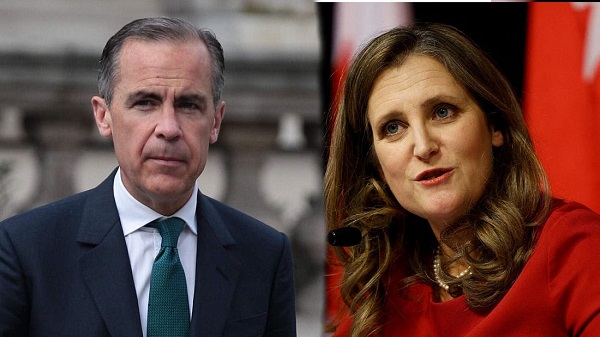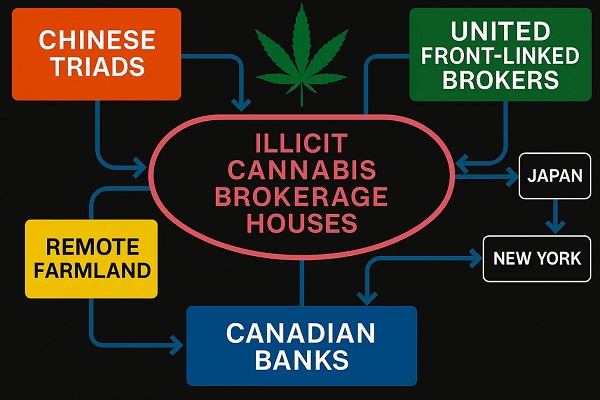Business
Exodus of young people suggests Ontario is an increasingly less-desirable place to live

From the Fraser Institute
By Jake Fuss and Grady Munro
Over the four years from 2020/21 to 2023/24, Ontario saw 104,426 people (on net) leave the province and migrate to somewhere else in Canada. This concerning trend of out-migration, particularly among working age individuals, suggests the province is an increasingly less-desirable place to live and work—and policymakers should take notice.
Using data from Statistics Canada, we can see that over the four year period from 2020/21 to 2023/24 (the latest year of available data), 277,299 people migrated to Ontario from other provinces or territories while 381,725 left Ontario to move to a different province or territory. Put differently, Ontario saw a net loss of 104,426 people to the rest of Canada.
We can further break down this data by age. Looking at working age individuals (15-64 years old), Ontario had a net loss of 80,323 people from 2020/21 to 2023/24. If we zero in further, roughly 39 per cent (40,608 individuals) of the total net loss during those four years were young individuals aged 20-34 years old.
These are concerning trends. Not only have more individuals been leaving Ontario than are coming from other provinces in recent years, but a significant share of those who are leaving are young adults—those who may be finishing school, starting a career or a family, and who have the potential to contribute greatly to the overall standard of living in Ontario over the course of their lifetime.
So, why might Ontario be increasingly viewed as a less-desirable place to live?
First and foremost, Ontario’s economy is broken and provincial living standards have been falling behind the rest of Canada for decades. In 2000, per-person GDP—a broad measure of individual living standards—was $63,146 (inflation-adjusted), nearly 5 per cent higher than the rest of Canada. Yet growth in Ontario’s per-person GDP (inflation-adjusted) has slowed since then and provincial living standards in 2023 were 3.2 per cent lower than the rest of Canada. In other words, over the last two decades Ontarians went from enjoying a higher standard of living than the rest of the country, to now suffering lower living standards.
Ontarians are further saddled with some of highest tax rates in North America. For example, an Ontarian earning C$150,000 per year faces the third highest combined (federal/provincial) marginal personal income tax rate of anywhere in Canada and the United States.
And the Ford government’s continual debt accumulation—including massive projected deficits of $14.6 billion this year and $7.8 billion next year—suggests taxes in Ontario could rise further in the years to come.
High tax rates take away more of your hard-earned money and discourage skilled workers (including doctors, engineers and entrepreneurs) from living and working in the province—meaning future tax hikes will only further weaken Ontario’s already-struggling economy.
Finally, Ontarians (particularly younger individuals) may be leaving the province in search of more affordable housing. Ontario is ground zero for Canada’s housing affordability crisis and there are few signs this will change anytime soon. Home prices and rents are through the roof due to a lack of housing supply, and recent efforts by the Ford government to try and spur more homebuilding will do little to help (despite their considerable cost).
Migration numbers suggest that Ontario is increasingly becoming a less desirable place to live and work compared to the rest of Canada. If the Ford government is to stop the exodus, it must balance the budget, lower taxes, and meaningfully address housing affordability.
Business
BC Ferries: Emails Change Everything- Committee to Haul In Freeland & Co.

Freeland, Public Safety, Seaspan, Irving, Ontario yards and unions to appear as MPs probe what Ottawa knew and when.
In Ottawa they call it “arm’s-length.” Out in the real world, people call it duck-and-cover. At Meeting No. 6 of the House of Commons transport committee, MPs confronted a simple, damning timeline: Transport Canada’s top non-partisan official was warned six weeks before the public announcement that BC Ferries would award a four-ship contract to a Chinese state-owned yard. Yet the former transport minister, Chrystia Freeland, told Parliament she was “shocked.” Those two facts do not coexist in nature. One is true, or the other is not.
There’s an even bigger betrayal hiding in plain sight. In the last election, this Liberal government campaigned on a Canada-first message—jobs here, supply chains here, steel here. And then, when it actually mattered, they watched a billion-dollar ferry order sail to a PRC state yard with no Canadian-content requirement attached to the federal financing. So much for “Canada first.” Turns out it was “Canada… eventually,” after the press release.
Conservatives put the revelation on the record and asked the only question that matters in a democracy: what did the minister know and when did she know it? The documents they cite don’t suggest confusion; they suggest choreography—ministerial staff emailing the Prime Minister’s Office on how to manage the announcement rather than stop the deal that offshored Canadian work to a Chinese state firm.
Follow the money and it gets worse. A federal Crown lender—the Canada Infrastructure Bank—underwrote $1 billion for BC Ferries and attached no Canadian-content requirement to the financing. In plain English: taxpayers took the risk, Beijing got the jobs. The paper trail presented to MPs is smothered in black ink—hundreds of pages of redactions—with one stray breadcrumb: a partially visible BC Hydro analysis suggesting roughly half a billion dollars in B.C. terminal upgrades to make the “green” ferry plan work. You’re not supposed to see that. You almost didn’t.
How did the government side respond? With a jurisdictional shrug. We’re told, over and over, that BC Ferries is a provincial, arm’s-length corporation; the feds didn’t pick the yard, don’t run the procurement, and therefore shouldn’t be blamed. That line is convenient, and in a technical sense it’s tidy. But it wilts under heat. The federal lender is still federal. The money is still public. If “arm’s-length” means “no accountability,” it’s not a governance model—it’s a get-out-of-jail-free card.
The fallback argument is economic fatalism: no Canadian shipyards bid, we’re told; building here would have taken longer and cost “billions” more. Maybe that’s true, maybe it isn’t—but it’s the sort of claim that demands evidence, not condescension. Because the last time Canadians heard this script, the same political class promised that global supply chains were efficient, cheap and safe. Then reality happened. If domestic capacity is too weak to compete, that’s not an argument for outsourcing permanently; it’s an indictment of the people who let that capacity atrophy. And if you swear “Canada first” on the campaign trail, you don’t bankroll “China first” from the Treasury bench.
Even the process looked like a master class in delay. The committee repeatedly suspended to “circulate” and “review” lengthy motions, while edits ricocheted across the witness list. There were pushes to pare back which ministers would appear at all, and counter-moves to tuck sensitive testimony behind closed doors. In the end, members nudged toward a compromise—Public Safety in open session, other national-security witnesses in camera—but the pattern was unmistakable: every procedural minute spent on choreography was a minute not spent on the timeline.
And after all that stalling, here’s who they’re hauling in—because even Ottawa’s fog machine couldn’t hide the paper trail forever.
They moved to recall Chrystia Freeland herself—the minister who claimed to be “shocked” after her own department had a six-week head start. She’s the centerpiece witness, and rightly so.
On the security front, the Public Safety Minister is slated for an hour in public, followed by an hour with officials, while the national-security reviewers will give their evidence in camera—translation: the part you most want to hear will happen behind closed doors.
Industry voices are on deck too: Seaspan (the transcript garbles it as “C-Span”), Irving Shipbuilding, plus labour and trade heavyweights—the BC Ferries & Marine Workers’ Union, BC Building Trades, the BC Federation of Labour, the Shipyard General Workers Federation, and the Canadian steel producers—the people who can say, under oath, exactly what Ottawa knew and when the alarm bells rang.
They even tacked on Ontario shipyards via a “friendly amendment”—because apparently no one thought to ask central Canada’s yards until the story blew up.
And then the hedge: Liberals worked the amendments to pare back which ministers would face the lights—especially Revenue and Labour—prompting Conservatives to call the move “intolerable.” In other words, invite the easy witnesses, bury the consequential ones. The fight over those two remained live at that point.
So yes, the committee will finally hear from the people who matter—Freeland, Public Safety, shipyards, unions, steel. But notice the choreography: showcase the safe bits in public, tuck the sensitive parts out of view, and keep chipping away at the ministerial witness list. That’s not transparency; that’s stage management with a security badge.
Strip away the talking points and what remains are questions no serious government would duck. When did the minister learn the contract was going to China? What did her office tell the PMO and when? Why did a federal loan—the leverage Ottawa actually controls—carry zero requirement to build any of it here? And why are the documents that might answer those questions buried under redactions thick enough to pave a road?
Canadians are not children. They understand that ferries are essential and that delays are costly. They also understand something else: when a government runs on Canada first and then cheers from the dock as the jobs steam away, that’s not “arm’s-length.” That’s arm’s-length accountability—which is to say, none. Until the emails are unredacted and Chrystia Freeland answers the timeline under oath, the government’s position amounts to this: trust us, the money’s independent, the decisions were someone else’s, and the facts you’re not allowed to see fully vindicate us. Sure. And the check is in the mail.
Subscribe to The Opposition with Dan Knight
Business
PBO report projects soaring deficit and debt interest charges

The Canadian Taxpayers Federation is calling on Prime Minister Mark Carney to cut spending following today’s Parliamentary Budget Officer report forecasting the deficit to “increase sharply.”
“The PBO report should be a five-alarm siren to end the government’s debt-fueled spending spree,” said Franco Terrazzano, CTF Federal Director. “Carney must change course and cut spending because taxpayers can’t afford to pay more than $1 billion every week to cover the government’s debt interest charges.”
The PBO’s Economic and Fiscal Outlook projects this year’s “deficit to increase sharply to $68.5 billion.”
Carney’s annual borrowing will add about $255 billion to the debt over four years, according to today’s PBO report. For comparison, former prime minister Justin Trudeau planned on increasing the debt by $131 billion over those years, according to the most recent Fall Economic Statement.
Debt interest charges will cost taxpayers $55.3 billion this year, according to the PBO. That means the federal government will waste more money paying interest on the debt than it sends to the provinces in health-care transfers ($54.7 billion). Debt interest charges will cost taxpayers $82.4 billion in 2030.
“The federal debt-to-GDP ratio is projected to increase from 41.7 per cent in 2024-25, rising above 43 per cent over the medium term,” according to the PBO.
The Carney government’s spending is projected to increase by billions of dollars every year, according to the PBO.
“Carney sold Canadians on the idea he wasn’t like Trudeau and when it comes to the debt here’s the truth: Carney plans to borrow billions of dollars more than Trudeau,” Terrazzano said. “After a decade of out-of-control spending, Carney must make government more affordable and cut spending.”
The Carney government will release its first budget on Nov. 4.
-

 Business24 hours ago
Business24 hours agoTaxpayers: Stop wasting money and scrap the gun ban
-

 Business1 day ago
Business1 day agoWEF has a plan to overhaul the global financial system by monetizing nature
-

 Alberta11 hours ago
Alberta11 hours agoAlberta teachers to vote on tentative agreement with province
-

 Alberta1 day ago
Alberta1 day agoAlberta pro-lifers demand protections for infants born alive after failed abortions
-

 Business2 days ago
Business2 days agoGoogle Admits Biden White House Pressured Content Removal, Promises to Restore Banned YouTube Accounts
-

 Crime1 day ago
Crime1 day ago1 dead, 2 injured after shooting at Dallas ICE facility
-

 Business2 days ago
Business2 days agoGoogle says Biden admin ‘pressed’ it to censor some COVID-19 content
-

 Daily Caller1 day ago
Daily Caller1 day agoTrump’s Ultimatum To Europe On Russian Oil









